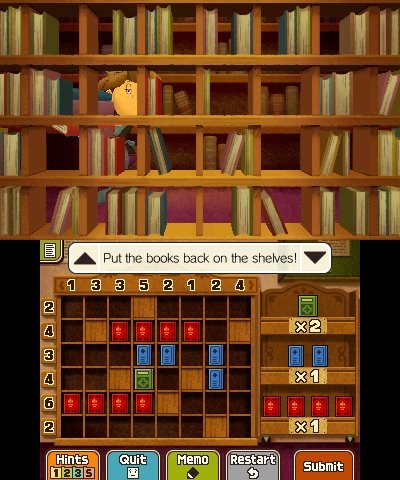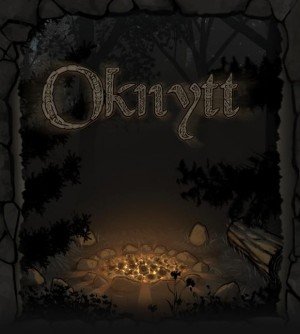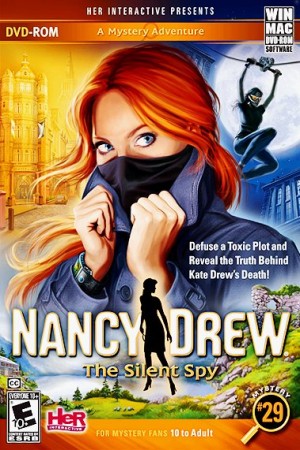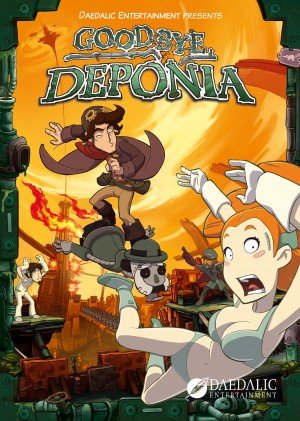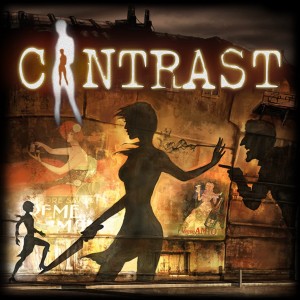Review for Professor Layton and the Azran Legacy page 2
In his last two investigations, Professor Layton came across some of the marvels left behind by the incredibly ancient Azran civilization. With major feats of engineering that are still fully functional millennia after its creators disappeared, this was clearly a culture with knowledge far in advance of even modern mankind. In his sixth adventure, The Azran Legacy, Layton is contacted by fellow archaeologist Professor Sycamore, who claims to have discovered a living mummy in the frozen town of Froenberg. This discovery will send Layton and companions round the world as they try to unlock the secrets the Azran left behind. But our protagonists are not the only ones on the trail of those secrets. The mysterious organisation known as Targent, led by the sinister Bronev, are also after the Legacy. The resulting adventure is a grand finale to the Professor’s Azran adventures, with only the occasional odd choice here and there to detract from the journey.
The story builds on events in Professor Layton and the Last Specter and Professor Layton and the Miracle Mask. Whilst it might be possible to follow the story without playing these two episodes, a handful of events will only really be clear to those that have played both. The Professor’s companions, Emmy and Luke, join him in his travels again, and a host of other familiar characters also put in an appearance. The living mummy proves to be just that: an Azran girl called Aurora who has been kept in suspended animation within a large block of ice. It is she who reveals to the Professor that there are five Azran eggs scattered across the globe that are the key to revealing her people’s legacy. Using the mighty airship Bostonius, the characters circumnavigate the world to find the eggs, constantly beset by agents of Targent. Whilst serious in overall tone, the story still finds time for the series’ trademark sense of humour as well. A particular recurring theme in this vein are two Targent agents, the over-excitably inept Bishop and his long-suffering partner Rook.
Once the eggs are eventually gathered, the story builds to a dramatic conclusion, with many surprise revelations. In this last respect the writers got rather carried away. The first few are shocking, but after that they keep coming so thick and fast that by the end each new stunning revelations arrives barely 30 seconds after the last. Whilst the finale is still satisfying, this narrative excess does somewhat mar the effect as the constant surprises start to become silly.
The best part of the story for me was the sheer freedom that it allows during a huge chunk of play time. For the first couple of chapters you are restricted by the need to wake Aurora, then rescue her when she is kidnapped by Targent. Once you reach the story’s main quest – the search for the five eggs – the world opens up. Whilst this section is only labelled as a single chapter, each fictional egg location is effectively its own chapter. However, except for a few key story sections in each location, you can wander back and forth between the five disparate locales to your heart’s content. What’s more, you can also revisit three locations from the earlier chapters that don’t have eggs in them at all. Each place has its own self-contained story and overall mystery to solve, but there are also nice little touches tying them together. Characters from one place will often pop up in others after you first encounter them. My favourite was finding that the dour Inspector Chelmey, a recurring character from previous games, is on a world tour with his much cheerier wife. By strange coincidence, this world tour just happens to take in every major location of your quest. The downside of this global freedom is that the movement around each individual area is somewhat limited. It is hard to feel you are in the bustling city of London when you can visit fewer than a dozen locations there.
Navigation and interaction are handled the same way as in the previous episode. The cursor highlights over interactive objects, making finding hint coins easier. To offset this, finding some hint coins requires multiple interactions. Sometimes these are repeated clicks in one place, such as those needed to consume an entire cake with a coin at its center. Sometimes you must click multiple spots, with certain movements such as opening or closing doors affecting how other hotspots operate. The “zoom” option is used again as well. Once more, in some locations this allows you to zoom in on a particular area, revealing additional details. Were this to allow you to more closely examine interesting details of a scene, this could have been something new. However, the zoom actually takes you to a new area, such as an alley between two buildings, and reveals items not even seen in miniature in the main view. Since opportunities to zoom are almost always blatantly pointed out, the only difference between this and normal travelling is that the zoomed location does not show on the map.
The sound is as good as in the previous instalments, with all of the main voice actors putting in first-rate performances for the most part. There are one or two lines that could have benefitted from re-recording, but these are so few amongst the wealth of dialogue as to be hardly noticeable. The new characters are equally well-voiced, particularly the villainous Bronev and his slightly gravelly voice. The soundtrack also continues to impress, with gentle string pieces giving way seamlessly to more grim tunes as the action requires. Some of the musical themes will be familiar to players of previous instalments, but this just serves to show how memorable that music is.
The graphics still have the same high-quality European animation style of the previous episodes. Encompassing a varied range of settings from a tropical jungle to a snowy mountaintop, each scene is filled with a wealth of detail that really brings the varied locations to life. Good use is made of the platform’s 3D capabilities as well, with every scene having several layers of detail that build to a fully three-dimensional effect. The full-sized character models have been better integrated, working perfectly together with the backgrounds this time around. The animations are also top-notch, especially in the short but beautifully crafted cutscenes. Not satisfied with simply improving the basic look of the game, however, the designers have taken it to another level in one sequence involving a first-person view as the Bostonius pursues a Targent airship. The landscape sweeping past, beginning with fields of snow and ending at a temperate lake, is without doubt the most stunning use of the technology I have seen to date.
But you don’t play a Layton game just to admire the scenery. As in previous games, there is an abundance of puzzles to discover. Many of the people you meet in your quest will ask you to solve puzzles for them, and you will also find puzzles directly blocking your path on occasion. As usual, you will need to have solved a certain number of puzzles to progress at certain points in the game, though this should not prove an issue. The main problem, once again, is that many of these puzzles appear to exist solely for their own sake. This issue is made worse in sections where the story indicates that time is running out, though the game will usually only progress at the player’s pace. This can lead to the protagonists appearing to have attention deficit issues, effectively saying “There’s no time to waste…….Oooh look! A puzzle to solve!” Suspension of disbelief would have been better served if these sections, at least, only included story-specific puzzles.
The puzzles are all new, but still maintain the high quality and variety of previous Layton instalments. You will try to arrange sets of books on shelves, reconstruct broken signs and face fiendish logic puzzles. As well as the in-game puzzles, there are unlockable sets of puzzles for certain achievements, as well as downloadable daily puzzles. As before, hint coins can be found throughout the world, allowing you to unlock progressively more detailed clues to solving each puzzle if necessary.
The gameplay doesn’t stop there though. Once more there are optional standalone games to be played from the menu found in the Professor’s trunk. This time around you are charged with rolling a squirrel’s precious nut so it lands exactly in his storage spot and bringing wilted gardens back to life. Both minigames have ten different levels, unlocked throughout the main game. The mechanics for each is simple: In the squirrel game you just choose how to set some boulders and the precious nut rolling, and in the garden you plant flowers that encourage growth in different patterns around them. Despite their apparent simplicity, both prove to be fiendishly difficult challenges at the higher levels.
Yet there is more. Various characters you meet on your quest will ask you to put together outfits for them. Each character gives you some simple statistic-based requirements at first, such as how cute or trendy the outfit must be. Once an outfit is shown to them, they will usually refine their requirements by asking for certain specific qualities, like a colour or particular theme. There are eight outfits to compile altogether, with a bonus set of puzzles unlocked for meeting all eight requirements simultaneously. This is not an easy task when you have only one of each item and have to switch things between outfits to find the perfect solution. There are also reports from the World Times of strange goings-on in places you have visited. Revisiting those locations allows you to investigate these peculiar events, finding the mundane truth behind the lurid headlines. There are twenty stories in all to be discovered, with another set of bonus puzzles unlocked for solving them all.
Still not enough extra content? The Azran Legacy has one more puzzling trick up its sleeve, offering a world-spanning treasure hunt challenge. Scattered throughout the world are various objects and creatures designated as treasure hunt items. These include such things as a red telephone box, a horned owl and a mini-snowman. Once you have spotted these during normal gameplay, they are added to your list of known hunt items. Challenges consisting of three items from this list can then be set, to be exchanged with other players via the console’s wireless StreetPass feature. Those not wishing to wait for meetings with other players can also create random challenges for themselves using the console’s built-in Play Coins system.
There is one unfortunate puzzle choice that has carried over from the previous game. There is an unavoidable action sequence near the start, completely out of keeping with the rest of gameplay. This occurs as part of the pursuit of Targent’s airship. In an attempt to eliminate their pursuers, the Targent crew unleash a variety of drones and missiles to bring you down, which you must destroy against the clock according to strict instructions for each set. These instructions include blowing up only blue drones, or shooting down missiles in numerical order. Success at each set results in an encouraging shout from the Professor or one of his companions and the pursuit continues. Failure results in a distressed shout from the Professor or one of his companions… and the pursuit continues. That’s right, having played the sequence through several times I could detect no game-changing differences between success and failure. Failure did not even make the sequence any longer. Even more disappointingly, achieving perfection did not result in a reward being unlocked either, rendering the whole thing rather pointless. Unless you are particularly up for the challenge, I would heartily recommend just watching the stunning scenery effects instead.
The sixth and possibly final solo instalment of Professor Layton is not quite perfection, with a couple of odd choices in design just taking the edge off. It is pretty close though, with stunning graphics, a gripping story and more challenging puzzles than you can shake a stick at. Add in all the extra optional content heaped on top of the main story and you could never accuse the developers of not giving value for money. Whilst some of the final story elements go a bit far, the tale of Professor Layton and the Azran Legacy comes to a satisfying conclusion, bringing the entire story full circle to latch on to the start of the very first game in the series. Fans of the series will certainly not be disappointed, and new players will discover a game that shows all that the 3DS is capable of. My only real disappointment is that the game’s conclusion suggests there will be no more tales of the Professor. I’d hate to see the end of such a good thing, but if that is indeed the case, this is undoubtedly a series going out on an incredible high.







